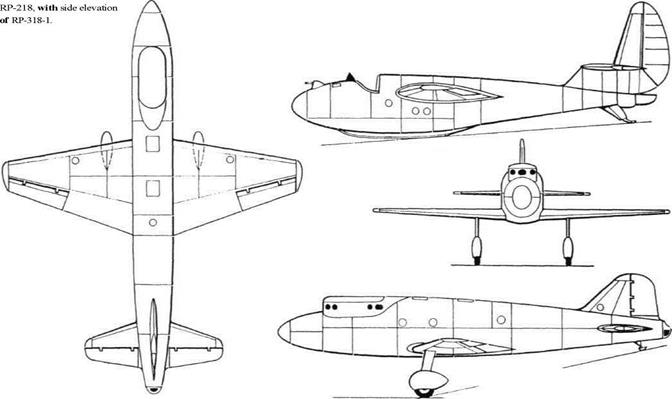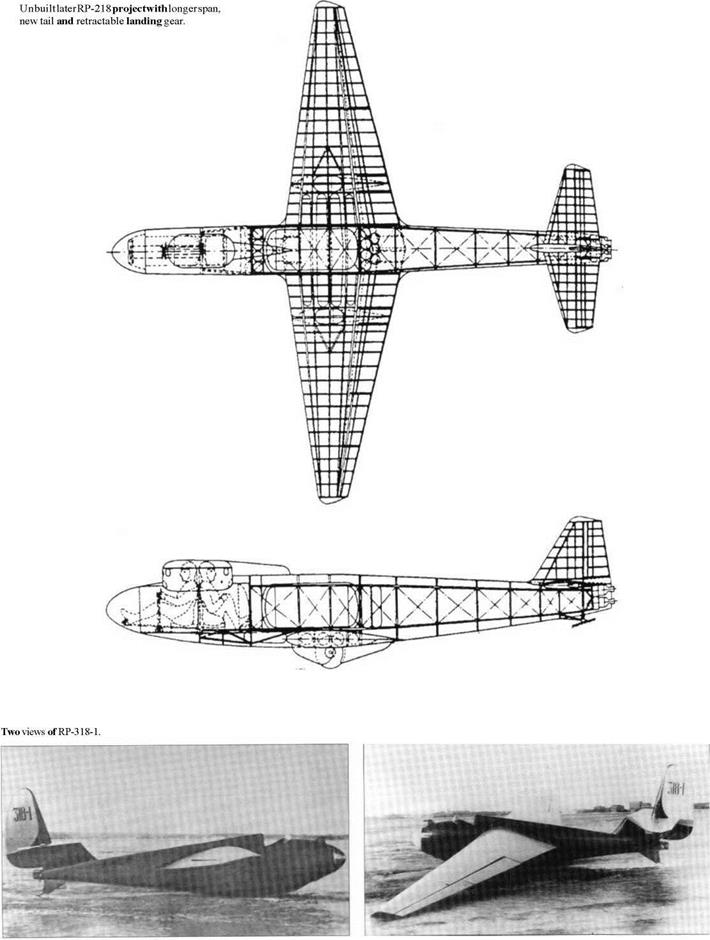Korolyov RP-318-1
Purpose: To test a liquid-propellant rocket engine in flight.
Design Bureau: RNII, rocket-engine scientific research institute; head ofwinged-aircraft department Sergei Pavlovich Korolyov.
Korolyov was a pioneer of light aircraft and, especially, high-performance gliders before, in early 1930s, concentrating on rocketry. In
1934 he schemed the RP-218, a high-altitude rocket aircraft with a two-seat pressure cabin and spatted main landing gear. The engines were eventually to have comprised three RD – 1, derived from the ORM-65 (see below), and in a later form the structure was refined and the landing gear made retractable. The RP – 218 was never completed, partly because Korolyov was assigned to assist development of the BICh-11 (see under Cheranovskii). In
1935 he produced his SK-9 two-seat glider, and suggested that this could be a useful rocket test-bed. In 1936, in his absence on other projects, A Ya Shcherbakov and A V Pallo began converting this glider as the flight test-bed for the ORM-65. This was fired 20 times on the bench and nine times in Korolyov’s RP-212 cruise missile before being installed in the RP-318 and fired on the ground from 16th December 1937. The ORM-65 was
then replaced by the RDA-I-150 Nol, cleared to propel a manned aircraft. This engine was repeatedly tested on the ground, and then flew (without being fired) in four towed flights in October 1939. After further tests the RP-318 was towed off on 28th February 1940 by an R-5 flown by Fikson, with Shcherbakov and Pallo as passengers in the R-5. The SK-9 was released at 2,800m, and then glided down to 2,600m where pilot Vladimir Pavlovich Fedorov fired the rocket. The SK-9 accelerated from 80 to 140km/h on the level and then climbed to 2,900m, the engine stopping after 110 seconds. Fedorov finally landed on a designated spot. Shavrov: This flight was of great significance for Russia’s rocket engines’. Much later Korolyov became the architect of the vast Soviet space programme.
The RP-318-1 was based on the SK-9, a shapely sailplane of mainly wooden construction. The rear seat was replaced by a vertical Dl light-alloy tank for 10kg (22 Ib) of kerosene, and immediately behind this were two vertical stainless-steel tanks projecting up between the wing spars each holding 20kg (441b)of RFNA (red fuming nitric acid). The rocket engine and its pressurized gas feed and complex control system were installed in the rear fuselage, the thrust chamber being
beneath the slightly modified rudder. The RDA-I-150 was a refined version of the ORM – 65, designed jointly by V P Glushko and L S Dushkin. Design thrust was 70 to 140kg at sea level, the figure actually achieved being about 100kg (220.5 Ib). An additional ski was added under the fuselage.
This modest programme appears to have had a major influence on the development of Soviet rocket aircraft.
|
Dimensions Span Length Wing area |
17.0m 7.44m 22.0m2 |
55 ft 914 in 24 ft 5 in 237ft2 |
|
Weights |
||
|
Empty |
570kg |
l,2571b |
|
Propellants |
75kg |
1651b |
|
Loaded |
700kg |
1, 54315 |
|
Performance |
||
|
Restricted by airframe to |
165km/h |
102.5 mph |
|
|
|












